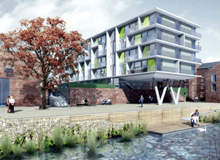
Though they thrive on creativity and innovation, architects’ practices are all too often constrained by outdated managerial approaches and hierarchical structures. That is the thinking of a growing number of new practices, among which Space Craft Architects presents a successful example of how a new take on management style can deliver benefits to both the practice and its clients.
BREAKING WITH TRADITION
Space Craft Architects was set up by Nik Randall in 2003, on his departure from Brookes Stacey Randall after 17 years of service.
Bringing with him his former associates and staff, Randall consciously and deliberately intended to break away from the traditional modus operandi of an architectural practice to foster a more collaborative, creative and open structure.
Reacting against his experience of the common hierarchical structure of a practice, Randall and his fellow directors have deliberately encouraged a flatter management structure, which clearly defines the role and responsibility of directors, but which also nurtures the skills of each individual at every level.
COLLABORATIVE CREATIVITY
How well do you really know your competitors?
Access the most comprehensive Company Profiles on the market, powered by GlobalData. Save hours of research. Gain competitive edge.

Thank you!
Your download email will arrive shortly
Not ready to buy yet? Download a free sample
We are confident about the unique quality of our Company Profiles. However, we want you to make the most beneficial decision for your business, so we offer a free sample that you can download by submitting the below form
By GlobalDataThe concept revolves around the ability of directors to bring their experience to bear in support of their designers, rather than dictating to them from above. In this safe, collaborative environment, Randall believes that creative individuals feel greater freedom to express themselves with the confidence that their colleagues will listen to them.
“People have no fear of coming forward with ideas. We have got very talented people and we wanted to develop a forum for them to explore their talents to the full. Our people’s responsibility is to the clients, so they don’t just have to do what the directors tell them. They are there to use their skills and knowledge to the best advantage,” says Randall.
Young designers are given a good degree of control over projects, each of whom is shadowed by one of the practice’s directors, who can add knowledge and skills derived from the successful management of previous projects to the ideas from the designer. Furthermore, a technical coordinator is available to consult on specific issues in any project, again with a background of practical experience.
In this manner, Randall hopes to transfer important skills to up and coming designers and find a synergy between innovative thought and experience.
OPEN STAFFING STRUCTURE
Also essential to the managerial mix is the environment in which designers work. This means not only the physical environment, but also the corporate culture that runs through the practice.
Randall believes that people should enjoy their work and that open, collaborative working methods go a long way towards making this happen.
“A lot of practices are too top-down, and designers only feel a responsibility to their line manager. With our management structure we have a very stable resource and few people leave. This is because they feel empowered by the responsibility, the support and the open structure,” remarks Randall.
CLIENTS CENTRE STAGE
The novel approach to internal management also creates informal relationships with clients. The professional distance between client and service provider makes way for closer partnerships, where clients take a more active role in the design process.
For Randall, the most important element of his new approach to the running of a practice is the treatment of the client. which requires designers at Space Craft Architects to dig deep into the briefs they are given and identify where the values lie for the client.
“We were keen that as a practice we would focus on where the value is for the client and not just design around the initial brief. By value, I don’t just mean financial value, I mean identifying what is central to the client’s goal with the brief, whether it is elegant design, gross/net balance, logistics and programming or any other factor,” he remarks.
“A lot of architects don’t spend time finding out what the client really wants. They don’t ask themselves why the client is going through such a process. Clients want a different kind of relationship, especially in the private sector, where they are keen on partnership with the design team,” he adds.
IMPROVED RELATIONSHIPS
For such an approach to deliver better results the buy-in of clients is crucial. A growing number of clients are looking for more collaborative relationships, with tangible results.
“The best clients, who get the best buildings for the best price, are those who are engaged with the project and who contribute to the design process. We want clients to be involved,” says Randall.
Client engagement allows the architect to point out opportunities that might not have been part of the initial brief. With client values clearly identified, these new opportunities can strongly reinforce the client’s goals in setting the brief.
At Space Craft Architects, the close client relationships allow designers to present options where different considerations – such as cost, design sophistication and probability of planning approval – are given different weightings. This puts clients in control of key decisions that will shape the final design.
“The architect can’t stand back. We provide the right options, each with recommendations and judged against the client’s core values,” says Randall.
MANAGEMENT PRINCIPLES SHAPE PROJECTS
Having taken a defiant stance on how a practice should be run, Randall and his fellow directors are now seeing their choices on management structure and client relationships feeding directly into completed designs and improving them.
For instance, a new school, soon to be completed in Kent for a public sector client, saw designers work around the key value of the teacher / pupil environment, giving a new focus for the design team and generating creative solutions within a fixed budget. Digging deep into the needs of the community, the pupils and the teachers added value but not cost.
INNOVATION AND IMAGINATION
Similarly, a residential regeneration project near Manchester for developer Urban Splash, featuring the conversion of a listed mill and the construction of surrounding buildings to make a new urban quarter, included an innovative development using interlocking apartments. Blending colour and form to ensure that no two apartments are the same targeted the need to give the development an edge in the market.
“Urban Splash is a very imaginative developer, which values what good architecture can bring to the mix. This building focused on the value of the commercial advantage that good design brings to a project. People queue up to buy their apartments,” notes Randall.
Though still a young practice, Space Craft Architects is growing steadily, and Randall puts its success down to its new approach to management as well as the skills of its individuals.
“We like to think of the structure of the office as a family tree. There are strong opinions expressed, even among the directors, but there is never a confrontational atmosphere. There is healthy debate. It encourages the best ideas to come out,” he says.
Putting people first could be the future of successful practices.






